Care and Maintenance of a Bassoon
Maintaining the Instrument after Performances
Thoroughly wipe away all internal moisture!
If water is allowed to remain on the inside surfaces of the bassoon, it could swell. Use a cleaning swab to wipe away all moisture without fail after every performance.
* Using a Yamaha swab with an instrument made by another manufacturer may cause problems, such as the swab becoming stuck in the bore, as there may be differences in the bore diameter. Please exercise caution.
Tenor joint
Thoroughly dry any water that has collected in the tone holes of the tenor joint by passing through a cleaning swab after blowing the water into the interior of the body. As the swab emerges, take care not to damage the pad on the whisper key (pianissimo key).
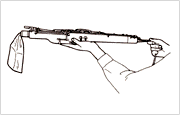
Double joint
-
1. Empty any water that has collected in the U-tube via the narrow end of the tube. Take care to avoid pointing the C# tone hole directly downwards while doing this, otherwise water may accumulate.
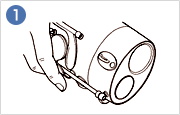
-
2. Insert the weight for a double joint cleaning swab into the bore on the bass joint side (the wider bore), and pull it out of the tenor joint side, to remove any moisture.
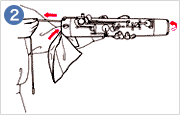
-
3. If moisture remains in the wider bore of the double joint, be sure to remove the U-tube and thoroughly dry any moisture within the bore. Also, if moisture remains on the inner surface of the A♭ tone hole at this time, wipe dry thoroughly.
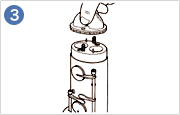
-
4. To prevent leakage of air, apply a small amount of cork grease to the surface of the cork packing attached to the U-tube.
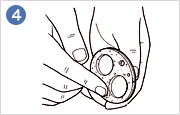
Washing the reed to remove dirt
"Bird feathers" can be used to clean dirt from the inside of the reed, and can be purchased from musical instrument stores.
Soak the reed in a large cup, and insert the feather from the end that is attached to the bocal during play (the end wound with yarn) then rotate the feather while moving it in and out of the reed to remove any dirt. However, it is important to take care when doing this as the tip of the reed is exceptionally thin, and it is possible to break or damage it if the feather gets caught on the reed during cleaning.
Any dirt on the outer surfaces of the reed can be gently rubbed away with the fingers. Finally, the whole reed should be rinsed with clean water.
It is best to clean the reed at regular intervals, as is true for the whole instrument. If done only occasionally, the feel of the reed when playing may be altered when cleaned.
Other maintenance that must not be forgotten
Taking care of the bassoon's finish
Wipe the surface of the instrument gently with a polishing cloth.
Taking care of the keys
Wipe the keys of the bassoon with a polishing cloth or a silver cloth.
Maintenance of the pads
Remove dirt and moisture from the pads by inserting cleaning paper into the small spaces between them and the tone holes.
Apply key oil once a month!
It is a good idea to apply a small amount of key oil between the keys and key posts around once a month. Wipe away any excess oil with cleaning paper. Any dust or debris in the small spaces such as the gaps between the instrument body and the keys should be removed using a tone hole cleaner.
* Please take care to avoid damaging tone holes or other parts of the instrument with the metal part of the tone hole cleaner.
Musical Instrument Guide : Bassoon Contents
Structure
- What Kind of Musical Instrument is a Bassoon?
- A Long Tube that can be Separated
- The Bocal and its Various Functions
- Unique Features of the bassoon, and How to Play
- [Experiment1]Comparing the Sound of Tone Holes cut Obliquely and Perpendicular
- [Experiment2]Encasing the Bore in Various Materials
- Bonus Experiment
How to Play
How the Instrument is Made
Choosing an Instrument
Trivia
- An Instrument that is Sensitive to Humidity
- Sounds from water in the U-tube?
- There's a needle in the bocal?!
- Comments by conductors caused popularity to tumble?
- Bassoon classics - Chamber music works
- Bassoon classics - Concertos
- Is the "contra-fagotto" a contrabassoon?
- What is the best tool to file a reed?
